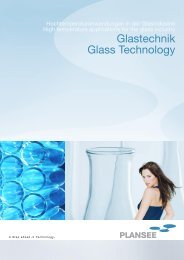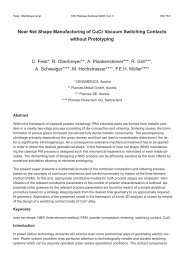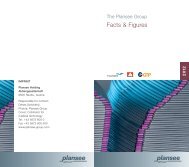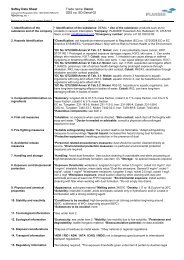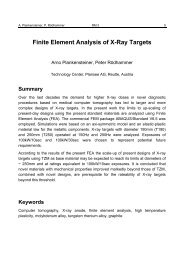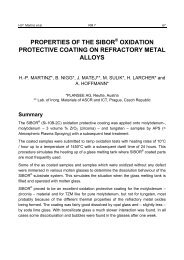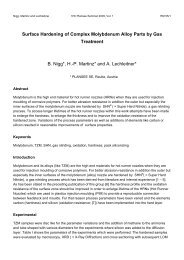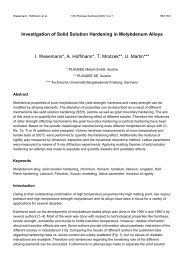Oxidation of Sputtered Thin Films of Molybdenum Alloys at Ambient ...
Oxidation of Sputtered Thin Films of Molybdenum Alloys at Ambient ...
Oxidation of Sputtered Thin Films of Molybdenum Alloys at Ambient ...
You also want an ePaper? Increase the reach of your titles
YUMPU automatically turns print PDFs into web optimized ePapers that Google loves.
RM 12/4 17th Plansee Seminar 2009, Vol. 1 List, Mitterer, Mori et al.<br />
Nevertheless, a more detailed analysis <strong>of</strong> the XRD peaks indic<strong>at</strong>ed slight changes, as summarized in<br />
Table II. For Cr, Ni and W, representing smaller or similar-sized <strong>at</strong>oms as Mo, macro-strains which are<br />
lower than those <strong>of</strong> unalloyed Mo films are observed, whereas for the larger Nb and Ta <strong>at</strong>oms higher<br />
macro-strains have been obtained. Similar arguments hold for the micro-strain induced by the elements<br />
Cr, Nb and Ta. While these simple interpret<strong>at</strong>ions are well suited to explain the strain gener<strong>at</strong>ed by<br />
alloying <strong>of</strong> Mo films with most <strong>of</strong> the elements used in this study, Ti does not seem to follow this trend.<br />
However, it has to be admitted th<strong>at</strong> in explaining solid solutions not only the effect <strong>of</strong> l<strong>at</strong>tice distortion has<br />
to be taken into account, but also the change in elastic properties and the chemical interaction between<br />
the individual <strong>at</strong>oms.<br />
Table II also shows the electrical resistivity <strong>of</strong> the films as determined by the four-point probe. The<br />
resistivity <strong>of</strong> the unalloyed Mo film agrees well to liter<strong>at</strong>ure d<strong>at</strong>a [9,10,11]. While alloying with Ti, Cr, Nb,<br />
Ta, and W does not affect the values significantly, the addition <strong>of</strong> Ni results in a three times higher<br />
resistivity.<br />
Table II: Summary <strong>of</strong> investig<strong>at</strong>ed alloying systems with the <strong>at</strong>omic radius <strong>of</strong> the respective alloying element, the film grain size,<br />
the diffraction angle 2 θ <strong>of</strong> the (110) XRD peak, the determined l<strong>at</strong>tice spacing, the macro-strain calcul<strong>at</strong>ed from the<br />
XRD peak shift <strong>of</strong> the (110) peak, the micro-strain calcul<strong>at</strong>ed from the broadening <strong>of</strong> the (110) peak using a Pseudo-<br />
Voigt fitting function, and the determined electrical resistivity <strong>of</strong> the films.<br />
Alloy<br />
system<br />
Atomic<br />
radius<br />
[pm]<br />
Grain size<br />
[nm]<br />
2 θ (110)<br />
[°]<br />
L<strong>at</strong>tice<br />
spacing<br />
[nm]<br />
Macrostrain <br />
Microstrain<br />
Electrical<br />
resistivity<br />
[µΩcm]<br />
Mo 136 42 40.41 0.2230 0.00223 0.00279 11<br />
Mo-Ti 144 37 40.48 0.2226 0.00057 0.00233 15<br />
Mo-Cr 125 45 40.53 0.2224 -0.00061 0.00263 14<br />
Mo-Ni 125 43 40.44 0.2229 0.00152 0.00293 33<br />
Mo-Nb 142 37 40.33 0.2234 0.00413 0.00295 14<br />
Mo-Ta 143 48 40.37 0.2232 0.00318 0.00288 14<br />
Mo-W 137 54 40.49 0.2226 0.00033 0.00261 12<br />
The c<strong>at</strong>hodic and the anodic electrochemical behavior <strong>of</strong> Mo and Mo alloy films, as measured in a 0.9 %<br />
NaCl aqeous solution against a s<strong>at</strong>ur<strong>at</strong>ed calomel electrode, is shown in Fig. 1. It can clearly be seen<br />
th<strong>at</strong> there are only small differences in the corrosion potentials and the corrosion current density <strong>of</strong> the<br />
individual films. The corrosion current density was measured to 0.13 µA/cm 2 for the Mo samples alloyed<br />
with Cr and Ni, 0.17 µA/cm 2 for the Mo-Nb film and 0.24 µA/cm 2 for those films alloyed with Ti, Ta and<br />
W. All these values are lower compared to the current density measured for Mo, i.e. 0.26 µA/cm 2 .<br />
However, it has to be mentioned th<strong>at</strong> the differences between the alloy systems for both, the corrosion<br />
potential and the corrosion current density, are rel<strong>at</strong>ively small and close to the st<strong>at</strong>istical measurement<br />
error. To illustr<strong>at</strong>e this, additional measurements were done for three film samples <strong>of</strong> the Mo-Cr system,<br />
being co<strong>at</strong>ed in the same deposition run. There, a corrosion potential <strong>of</strong> -270 ± 40 mVSCE and a<br />
corrosion current density <strong>of</strong> 0.13 ± 0.03 µA/cm 2 was obtained. This means th<strong>at</strong> the sc<strong>at</strong>tering <strong>of</strong> d<strong>at</strong>a for<br />
the corrosion potential is almost in the same order <strong>of</strong> magnitude as the differences measured (see Fig.<br />
1). Nevertheless, from the corrosion current density one can conclude th<strong>at</strong> Cr and Ni are most efficient in<br />
improving the corrosion r<strong>at</strong>e, whereas Ti, Ta and especially W do not affect the corrosion current density<br />
significantly compared to the unalloyed Mo film.



